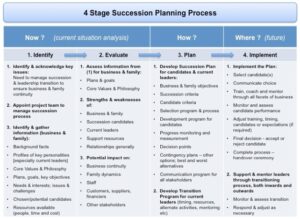“It is not the strongest of the species that survives, nor the most intelligent, but the one most responsive to change.”
Charles Darwin
Succession Planning – Overview
Family Business Succession is the transition, from one generation to the next, of ownership, leadership and/or management of the family’s business interests.
Succession should be seen as a natural and inevitable part of every family and business lifecycle, rather than as a personal cataclysm however, because it’s often delayed, denied, ignored, suppressed or botched, it creates more tension for individuals, families and businesses than all other causes put together.
Succession therefore justifies very special care and attention – whether in planning and managing the process; responding to the consequences of failing to plan and manage the process; or when having to deal with problems – expected or otherwise.
Succession Planning
There are many practical aspects to a good succession process, including: agreeing needs and objectives; benchmarking to other businesses; setting timeframes for tasks (including major milestones); identifying available candidates; people resources generally; process monitoring; communication plans, and allocating individual responsibilities.
Individuals, families and businesses get far more positive benefits from succession when they turn a potential challenge into a catalyst for renewal and positive change.
Technical issues are handled collaboratively by lawyers, accountants, finance experts, business advisers, marketeers and financial planners. Informed co-ordination is essential to keep costs under control.
The ultimate goals of the Succession Planning Process are to ensure that, at handover:
- The old leader is ready, willing and wanting to move into a new role/new life.
- A new leader is ready, willing and able to take over the top job.
- The family and business are happy about, and willingly support, the transition.
- All other interested parties are fully informed, and supportive of, the change.
Timing Issues
Succession is not a question of “if”, it’s a question of “when”. We all age, and eventually have to move on, especially when others are relying on us.
The standard wisdom is that: “Succession should be a planned and managed process, not an event” – to maximise benefits and minimise risk.
Ideally, the family and the business will spend at least five years actively grooming their successor teams. That amount of time allows a comprehensive handover of information and business smarts, plus enough settling in time to minimise disruption risk. The goal is to have successors: “standing on shoulders, not in shoes“.
A reasonable period allows the existing leader to get their head in sync with their heart over the personal implications of transition.
Anything less than 12 months in transition is a crisis. Less than two years is a challenge. Two to five years is workable, with serious effort.
Succession Project Plan
Our succession program works much like a normal business project – with identifiable targets, milestones, timelines, resource allocation, responsibilities and accountabilities. It also includes relevant measurement processes and tools and a comprehensive communication strategy.
Back to top
Transition Management – Tips and Traps
Unmet expectations and broken promises destroy trust and generate conflict in families. Failing to hand over leadership, and/or ownership, at the promised time causes deep resentment in families, and profound destabilisation in businesses.
Failing to hand over leadership, and/or ownership, at the promised time causes deep resentment in families, and profound destabilisation in businesses.
Delegating responsibility without providing corresponding authority doesn’t work either: “Don’t hand over the reins until you’re ready to get off the horse!“.
Handing over control, or partial control, too quickly, while the leader’s heart trails far behind their head – is another recipe for almost certain disaster. The current leader needs to be able to move aside emotionally, as well as intellectually.
If a normally rational business owner insists that a family member takes over the leader’s role, irrespective of their lack of suitability, skills or even desire for the position, they run a real risk of destroying their family, and their business.



